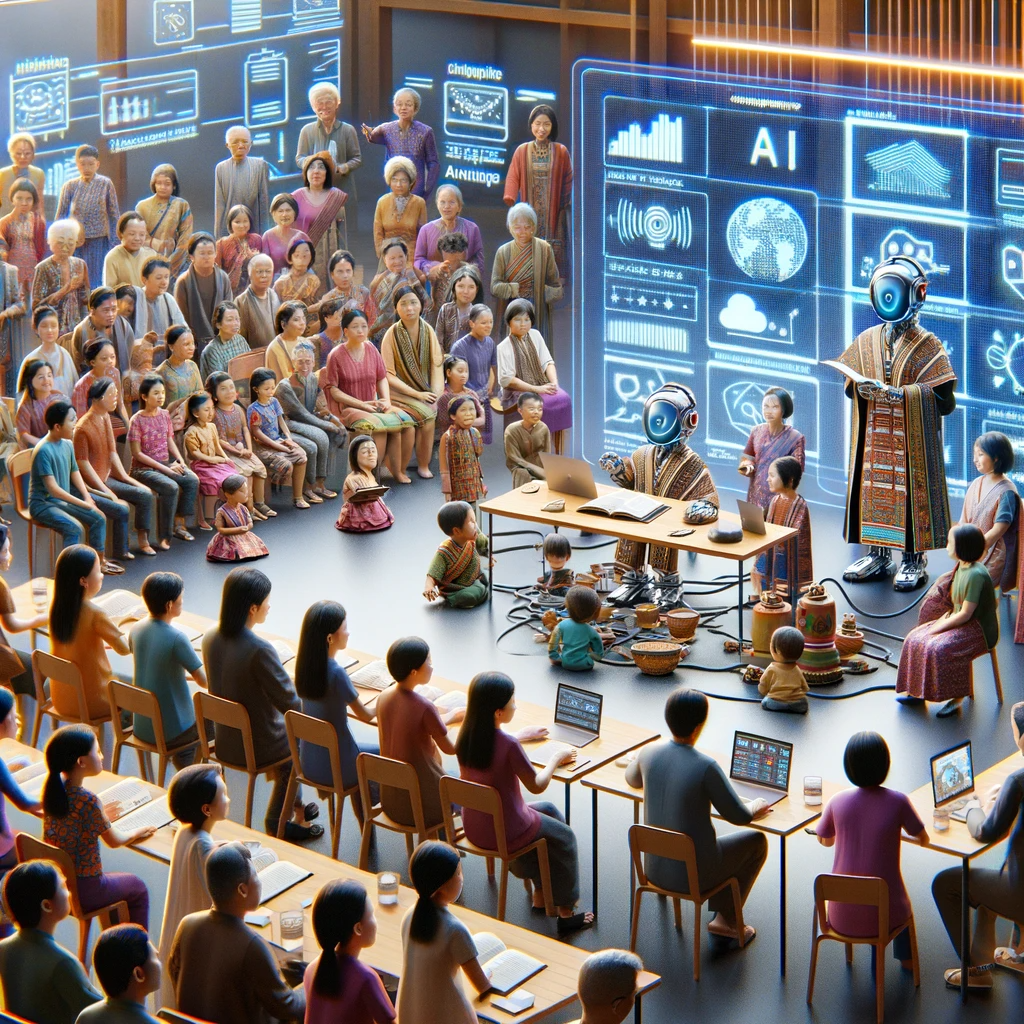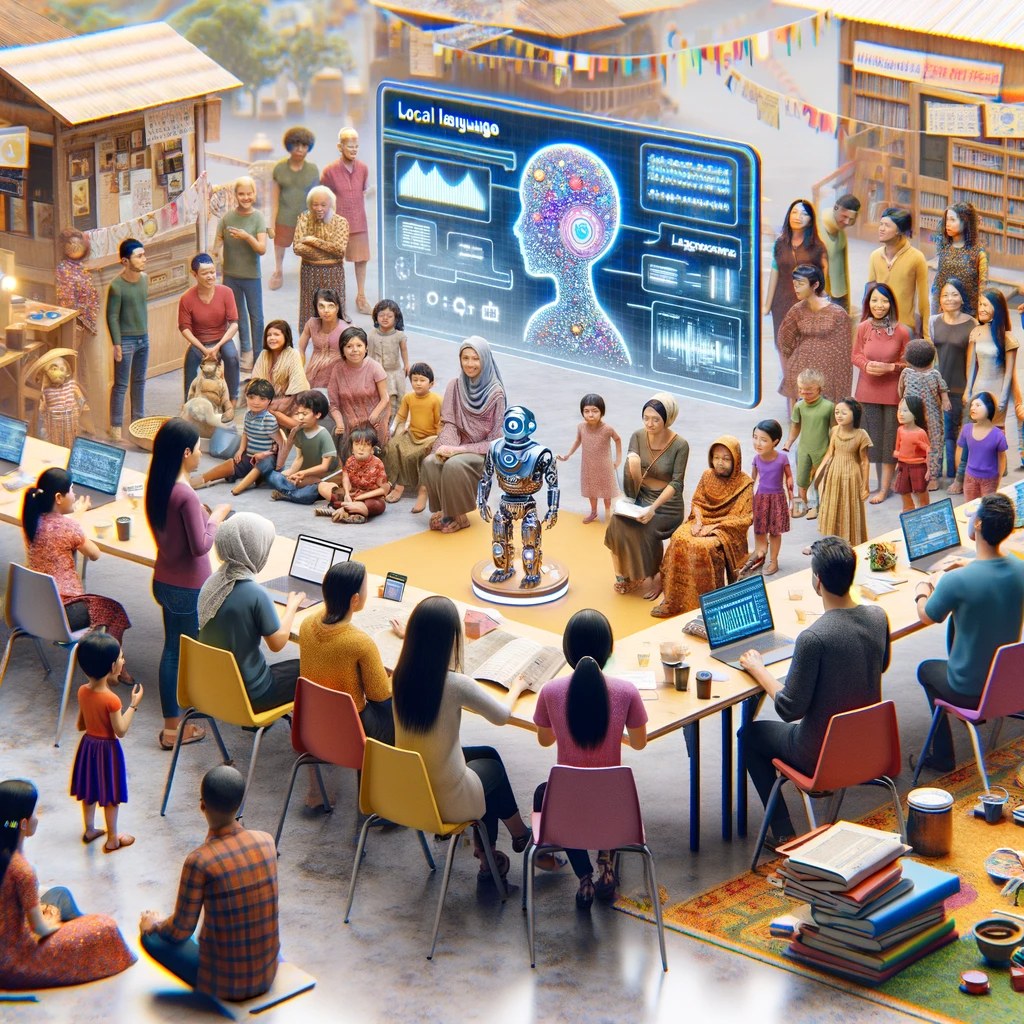In a world that is increasingly interconnected and digitized, the tapestry of human languages is at risk of unraveling. The rich mosaic of linguistic diversity, representing centuries of cultural heritage and human expression, faces a growing threat – the endangerment of languages. As languages teeter on the brink of extinction, the urgency to document, revitalize, and preserve them has never been greater. This is where the transformative power of Artificial Intelligence (AI) enters the stage.
The preservation of endangered languages is a global imperative. Every language represents a unique worldview, a repository of cultural knowledge, and a testament to the ingenuity of human communication. Yet, as globalization and urbanization advance, many languages are fading into obscurity, spoken only by a dwindling number of speakers, often from older generations.
In this digital era, AI is emerging as a beacon of hope in the endeavor to safeguard linguistic diversity. AI technologies, encompassing natural language processing, speech recognition, machine translation, and more, are not just tools for the future; they are becoming indispensable allies in the race against language loss.
This article embarks on a profound exploration of how AI is assisting in language preservation efforts. We will traverse the realms of linguistics, technology, and culture to understand the multifaceted role of AI in this noble cause. From the documentation of endangered languages to their revitalization, and from preserving cultural heritage to promoting linguistic diversity in the digital age, AI is a catalyst of transformation.
AI-driven language documentation tools are capturing oral traditions and ancient texts, transcribing them into digital formats, and creating invaluable linguistic archives. Language revitalization efforts are being reinvigorated with AI-powered language learning applications and virtual tutors, making the process more engaging and accessible.
Moreover, AI is aiding in preserving cultural heritage by digitizing folklore, songs, and historical texts associated with endangered languages. It is also fostering the promotion of these languages through translation tools and content generation, breaking down language barriers in the digital realm.
Yet, amidst this transformative journey, challenges and ethical considerations loom. Resource constraints, accuracy issues, and the need for informed consent must be navigated. Ethical concerns, such as respecting indigenous knowledge and cultural sensitivity, require thoughtful solutions. Collaboration between AI researchers, linguists, and native language speakers is paramount.
As we delve into the intricacies of AI’s role in language preservation, we will encounter success stories and case studies that illuminate the impact of technology on linguistic heritage. From the Maori language in New Zealand to the Navajo language in the United States, AI is leaving its indelible mark.
In this digital age, AI is not just a tool; it is a guardian of linguistic diversity, a bridge to our shared human heritage, and a promise of continuity for endangered languages. It is a testament to our collective commitment to preserving the voices of the past for the generations of the future
The Crisis of Endangered Languages
Languages are not merely a means of communication; they are repositories of culture, history, and identity. They shape the way we perceive the world, convey our deepest emotions, and pass down the wisdom of generations. However, a profound crisis looms over the linguistic landscape – the endangerment of languages. In this section, we delve into what endangered languages are, why their preservation is crucial, and the factors that contribute to their decline.
Defining Endangered Languages Endangered languages are those on the precipice of extinction, spoken by a diminishing number of speakers, often from older generations. They face the imminent risk of fading into oblivion, with no new speakers to carry them forward. The classification of endangered languages is typically based on the number of native speakers and intergenerational transmission trends.
The Importance of Preservation The preservation of endangered languages is far from a sentimental endeavor; it is a matter of profound cultural significance. Each language is a unique window into a distinct culture, offering insights into traditions, values, and ways of life. Losing a language means losing a part of our shared human heritage. Furthermore, language is intrinsically tied to identity. For many communities, the loss of their language equates to a loss of their sense of self.

Factors Behind Language Endangerment The decline of languages is driven by an intricate interplay of social, economic, and cultural factors. Globalization, urbanization, and the dominance of major world languages have led to the marginalization of smaller linguistic communities. Economic opportunities often lie in speaking dominant languages, further eroding the motivation to pass down endangered languages to future generations. As elders who hold linguistic knowledge pass away, the fragile threads connecting the past and the present are severed.
The Role of AI in Language Documentation As languages teeter on the brink of extinction, the need for their systematic documentation becomes paramount. AI is playing a pivotal role in this endeavor by offering efficient and scalable solutions. In the following section, we will explore how AI technologies, such as automatic speech recognition and natural language processing, contribute to the documentation of endangered languages. These tools enable linguists and communities to capture, transcribe, and preserve linguistic treasures that might otherwise be lost forever.
Revitalizing Endangered Languages with AI
Languages do not simply exist in a vacuum; they thrive when they are spoken, learned, and passed down through generations. In the face of language endangerment, the task of revitalization becomes crucial. This section dives into the ways AI is contributing to the revitalization efforts of endangered languages, offering a glimmer of hope for their resurgence.
AI-Powered Language Learning Applications Revitalizing a language often begins with teaching it to a new generation of speakers. AI-powered language learning applications have emerged as valuable tools in this context. These applications adapt to individual learners’ needs, providing personalized lessons and feedback. Whether through language apps, chatbots, or virtual tutors, AI makes the process of learning an endangered language engaging and accessible.
Engaging the Digital Natives In a world where digital technology is an integral part of daily life, engaging younger generations in language revitalization efforts is paramount. AI bridges the generation gap by offering interactive and tech-savvy methods of language learning. Gamification, augmented reality, and virtual reality experiences infused with language content capture the attention of digital natives, making language learning a captivating journey.
Preserving Cultural Heritage through Digitization Endangered languages are not just spoken; they encompass rich cultural heritage, including oral traditions, folklore, songs, and historical texts. AI plays a pivotal role in digitizing and archiving these cultural treasures. Advanced text recognition and digitization tools ensure that valuable content associated with languages is preserved in digital formats, safeguarding the essence of cultural identity.
AI-Enhanced Language Revitalization Programs Language revitalization programs benefit immensely from AI’s capabilities. AI-driven systems can create tailored learning materials, adapt curriculum content to individual learners, and provide real-time feedback on pronunciation and grammar. These programs empower communities to take ownership of their language revitalization efforts, revitalizing the language in a way that resonates with their cultural context.
Preserving and Promoting Linguistic Diversity in the Digital Age
In an increasingly connected world, the preservation and promotion of linguistic diversity require innovative approaches. AI steps into this role by enabling the translation of content into endangered languages and breaking down language barriers. Whether through machine translation or speech recognition, AI ensures that content can be accessed and understood in endangered languages, fostering their usage in the digital sphere.
Challenges and Ethical Considerations While the promise of AI in language preservation is immense, it is not without its challenges and ethical considerations. This section delves into the obstacles that must be navigated to harness AI’s potential fully.
Resource Constraints and Accuracy AI-driven language preservation efforts require resources, including access to technology, funding, and skilled personnel. The accuracy of AI models, particularly for lesser-documented languages, can be a concern. The availability of linguistic data for training AI systems also varies across languages.
Ethical Considerations and Informed Consent Respecting indigenous knowledge and cultural sensitivity is paramount in language preservation. AI initiatives must ensure that they operate with informed consent and in collaboration with the communities whose languages are being preserved. Ethical concerns include issues of ownership, representation, and control over language data.
Collaboration for Success To overcome these challenges and ethical considerations, collaboration is key. Linguists, AI researchers, community members, and policymakers must work together in a collaborative and inclusive manner. Shared guidelines, ethical frameworks, and best practices can help navigate the complex terrain of AI-driven language preservation.
Success Stories and Case Studies Amidst these challenges, there are inspiring success stories and case studies that highlight the tangible impact of AI on language preservation efforts. From indigenous communities in Australia using AI to revitalize their languages to global initiatives leveraging technology, these stories showcase the transformative potential of AI.

Conclusion
In the realm of language preservation, where time is of the essence and the stakes are immeasurable, Artificial Intelligence (AI) emerges as a beacon of hope. As we conclude our exploration of how AI is assisting in language preservation efforts, we are left with a profound understanding of the transformative power of technology in safeguarding linguistic diversity and cultural heritage.
The crisis of endangered languages, as discussed in our initial section, is not a distant concern; it is a pressing global issue. Languages, as vibrant reflections of culture and identity, hold intrinsic value. Preserving them is not merely an academic pursuit; it is a commitment to respecting the voices of communities, the wisdom of generations, and the sanctity of cultural memory.
Throughout this article, we have ventured into the multifaceted roles AI plays in addressing this crisis. From its pivotal role in language documentation, capturing the essence of spoken words and oral traditions, to its contribution to language revitalization through innovative language learning applications, AI is redefining the landscape of language preservation.
In the digital age, where the younger generation is often more connected to screens than to ancestral tongues, AI engages digital natives and breathes new life into language revitalization efforts. The fusion of technology and tradition, as exemplified by gamified language apps and immersive language experiences, makes language learning an adventure rather than a chore.
AI’s capacity to preserve cultural heritage through digitization ensures that the folklore, songs, and historical texts associated with endangered languages are not consigned to obscurity. This digitization, coupled with AI-enhanced language revitalization programs, empowers communities to take ownership of their linguistic heritage, forging a path towards revival that resonates with their cultural context.
Furthermore, AI extends its reach to promoting linguistic diversity in the digital realm, breaking down language barriers through translation and speech recognition. It ensures that content, from educational materials to digital media, can be accessed and understood in endangered languages, fostering their usage and relevance in the digital age.
However, in our journey through the realm of AI and language preservation, we have also encountered challenges and ethical considerations. The availability of resources, the accuracy of AI models, and ethical concerns related to informed consent and cultural sensitivity underscore the need for careful navigation in this domain.
Collaboration, as emphasized throughout the article, is the linchpin of success. Linguists, AI researchers, community members, and policymakers must work together, leveraging shared guidelines, ethical frameworks, and best practices to harness AI’s potential fully.
As we conclude, we are reminded of the success stories and case studies that illuminate the path forward. From indigenous communities in Australia using AI to revitalize their languages to global initiatives leveraging technology, these stories are testaments to the transformative potential of AI in language preservation.
In a world where the threads of linguistic diversity are at risk of unraveling, AI emerges as a guardian, a bridge, and a promise. It is a guardian of linguistic diversity, preserving the voices of the past for the generations of the future. It is a bridge, connecting cultures and communities, breaking down barriers in the digital age. And above all, it is a promise – a promise that the languages that have shaped our world and defined our identities will not fade into silence, but will continue to resonate through the ages.
